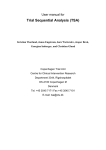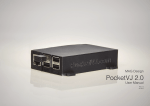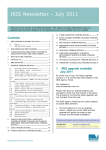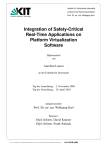Download E84 Data Logging Device (DLD) User Manual
Transcript
E84 Data Logging Device (DLD) User Manual Revision 2.8 E84 Data Logging Device (DLD) User Manual Revision 2.8 Table of Contents Overview ..................................................................................................................................................... 1 E84 Analysis Application ................................................................................................................ 1 E84 DLD ......................................................................................................................................... 1 Getting Started ............................................................................................................................................ E84 DLD Package Contents .......................................................................................................... E84 DLD Power Requirements ...................................................................................................... Typographical Conventions ............................................................................................................ 2 2 2 2 E84 Data Logging Device (DLD) Description .............................................................................................. 2 E84 DLD to Load Port Connection ................................................................................................. 2 E84 DLD Version Information ...................................................................................................................... 3 Configuring the E84 DLD ............................................................................................................................ Communicating with the E84 DLD ................................................................................................. DLD Power Requirements ................................................................................................. E84 Analysis Application COM Settings ............................................................................ E84 DLD Configuration Options ..................................................................................................... 3 3 3 3 4 Recording Data ........................................................................................................................................... Stored Data .................................................................................................................................... Live Data ........................................................................................................................................ Sampling Rate ................................................................................................................................ Timing Diagram Graph Update Rate .............................................................................................. E84 DLD Power On Graph Indicator .............................................................................................. E84 DLD Power Off Graph Indicator .............................................................................................. 6 6 6 7 7 7 7 Status LED’s ................................................................................................................................................ 8 DLD Power Indicator ...................................................................................................................... 8 DLD RAM Buffer Indicator .............................................................................................................. 8 Version History ............................................................................................................................................ 9 Technical Support ..................................................................................................................................... 10 E84_DLD_User_Manual.wpd E84 Data Logging Device (DLD) User Manual Revision 2.8 List of Figures Installed DLD ............................................................................................................................................... Help Menu ................................................................................................................................................... Record Using COM Menu ........................................................................................................................... Configure DLD Dialog Box .......................................................................................................................... Upload DLD Dialog Box .............................................................................................................................. DLD Power Up and Power Down Indicators ............................................................................................... E84_DLD_User_Manual.wpd 2 3 3 4 6 7 E84 Data Logging Device (DLD) User Manual Revision 2.8 Overview GCI’s E84 Recorder and E84 Data Logging Device (DLD) capture E84 Signal Streams associated with automated material handoff operations in semiconductor fabrication facilities. Both units connect in-line between Active (AMHS) and Passive (process equipment) E84 entities. The E84 Recorder connects to a personal computer to provide real-time monitoring and unlimited recording to disk. The compact E84 DLD is a self-contained unit capable of recording the last 50 material handoff operations to battery-backed memory. GCI’s E84 Analysis Application provides data analysis and management for both products. E84 Analysis Application GCI’s E84 Analysis Application is a menu-driven graphical user interface that runs on the Microsoft Windows 95/98, NT/2000, or XP operating system. It configures the E84 Recorder and E84 DLD, supports data recording via the E84 Recorder and E84 DLD, and uploads logged data from the E84 DLD. It provides playback features including scroll, zoom, time measure, and automated error analysis. Finally, the E84 Analysis Application can save and load recorded E84 Signal Streams via the PC’s hard drive. See the E84 Analysis Application User Manual for more details. The E84 Analysis Application and its User Manual can be downloaded from Get Control’s web site: http://www.getcontrol.com/products/e84analysis.html Upon request, Get Control may also provide a CDROM which contains these files. For more information, send email to [email protected]. E84 DLD GCI’s E84 DLD is a compact unit that plugs directly between the load port’s and optical transceiver’s DB-25 connectors. It non-intrusively senses the states of 15 E84 interface signals defined in the SEMI® E84 Standard. It is a stand-alone unit requiring only 250mW of power from the load port’s +24V supply. GCI’s E84 DLD captures the sensed E84 signal states to form E84 Signal Streams. It logs the E84 Signal Stream to its internal battery-backed memory and time and date stamps each signal transition. The battery-backed memory utilizes a ring buffer that is capable of storing the last 1000 E84 signal transitions (or a minimum of 50 material handoff operations). GCI’s E84 Analysis Application uploads the E84 Signal Stream by connecting a cable between the RS-232 port on the E84 DLD and the PC’s COM port. It displays uploaded E84 Signal Streams in a graph window for analysis and optionally stores them to disk. Optionally, the GCI Handheld Tester can be used to upload the DLD’s log file. GCI’s E84 DLD is an invaluable tool to determine the source of occasional handshake errors after they occur because it continuously logs changes in E84 signal states. The E84 Signal Stream for a faulted material handoff operation is available even after error recovery and several post-fault material handoff operations. Synchronizing the E84 Signal Streams to HSMS or other host work stream logs is easy since each signal state transition contains a Date and Time stamp. The GCI RJ-11 Optical Transceiver contains a built in E84 DLD, providing the same invaluable data logging capabilities as the E84 DLD. E84_DLD_User_Manual.wpd 1 E84 Data Logging Device (DLD) User Manual Revision 2.8 Getting Started E84 DLD Package Contents The E84 DLD package includes the following: • The E84 Data Logging Device (DLD). • This printed manual. • E84 Analysis Application Installation CD. E84 DLD Power Requirements • 250mW from +24V Load Port power on passive DB-25 pin 23. Typographical Conventions Except where there is a functional distinction between them, the term E84 DLD is intended to refer to both E84 DLDs and RJ-11 Optical Transceivers which have data logging functionality. E84 Data Logging Device (DLD) Description The E84 DLD is a self-contained unit housed by a small plastic enclosure, 3.8" x 2.1" x 0.8", terminated on its ends with male and female DB-25 connectors. A female DB-9 connector resides on its top panel. E84 DLD to Load Port Connection The SEMI® E84 Interface specification defines a hard-wired communications link and an optical communications link. The E84 DLD interfaces with Load Ports that interface with the AMHS using the optical configuration. The DLD resides in-line between the Load Port and its Optical Transceiver. The internal circuitry of the DLD allows it to non-obtrusively monitor the E84 interface. With an optical communications link, the AMHS and Load Port communicate with each other through two Optical Transmission Devices, one connected to each entity. The Passive Optical Transmission Device connects to the Load Port’s DB-25. To connect the E84 DLD to the E84 interface, unplug the Optical Transmission Device’s DB25 from the Load Port’s E84 port. Plug the male DB-25 on the DLD (labeled Load Port) into the Load Port’s E84 port. Plug the Optical Transmission Device’s male DB-25 connector into the female DB-25 connector on the DLD, (labeled Optical Transceiver). Installed DLD E84_DLD_User_Manual.wpd 2 E84 Data Logging Device (DLD) User Manual Revision 2.8 E84 DLD Version Information To determine the version of the E84 Analysis Application, select “About E84 Analysis Application” from the Help Menu. This option displays a dialog box Help Menu showing version number information for the E84 Analysis Application. For E84 DLD’s, the “About E84 Analysis Application” dialog always displays the message “E84 Recorder Not Connected” below the software version number. To determine the E84 DLD’s firmware version, use the Get Current DLD Settings option described below. The E84 DLD’s hardware revision number is printed on an internal circuit board, and is not visible to users. Configuring the E84 DLD The E84 DLD has several configuration options. The E84 Analysis Application provides a convenient interface to retrieve or modify the E84 DLD’s configuration. Communicating with the E84 DLD DLD Power Requirements The DLD must be powered before it can be configured. Normally, the DLD is installed on a piece of process equipment, and receives it’s power from the E84 interface it is connected to. Record Using COM Menu In this configuration, there are no additional power requirements. The DLD can be configured using the process described below. If the DLD is to be configured outside of the FAB, it must be connected to some alternate power supply. The DLD can be powered by the GCI E84 Emulator or the GCI Handheld Tester (HHT). When using the Emulator as the power source, connect the male DB-25 connector on the DLD (labeled “Load Port”) to the female DB-25 connector on the Emulator (labeled “Emulator is Passive Equipment”). Power ON the Emulator. The DLD’s power LED should turn ON. Connect the supplied DLD Comm cable (9-pin straight through male-to-female DB-9 cable) between the DLD and the PC. Follow the instructions below to communicate with the DLD. When using the HHT as the power source, connect the male DB-25 connector on the DLD (labeled “Load Port”) to the female DB-25 connector on the HHT. Power ON the HHT. At this point you have to enable the HHT’s 24V output in order to power the DLD. This can be done using Main Menu options 2, 3, or 5. Selecting any one of these options will turn the HHT’s 24V output ON. The DLD’s power LED should turn ON. Connect the supplied DLD Comm cable (9-pin straight through male-to-female DB-9 cable) between the DLD and the PC. Follow the instructions below to communicate with the DLD. E84 Analysis Application COM Settings Before any other configuration can take place, you must configure the E84 Analysis Application to communicate with the E84 DLD. Select “Record Using COM (E84 DLD)” from the Configuration menu in the E84 Analysis Application, and select the COM port to which the E84 DLD is connected. E84_DLD_User_Manual.wpd 3 E84 Data Logging Device (DLD) User Manual Revision 2.8 E84 DLD Configuration Options To configure an attached DLD, first select the desired COM port as described above. Then select the DLD Interface drop down menu, and select the Configure DLD option. This will display the Configure DLD dialog box. The Get Current DLD Settings button will attempt to communicate with a connected DLD and retrieve its current settings. This is a good test when bringing up a newly installed DLD to verify proper communications with the PC. After the PC retrieves the current DLD settings, the Date, Time, Daylight Configure DLD Dialog Box Savings, Version, and ID fields will be filled in with the current values from the DLD. If the attached DLD contains firmware version 2.0 or greater, the Counter section will also be updated. Note: the RJ-11 Transceiver does not support counters at this time. If connected to an RJ-11 Transceiver, the Counter section will remain blank. The Date, Time, and Daylight Savings fields represent the current settings of the DLD’s internal real time clock. The Version field is the DLD’s firmware version number. The ID field is a unique DLD identification string. Each DLD shipped from GCI is configured with a unique identifier. This allows the user to correlate DLD log information uploaded to a PC with a specific tool. After verifying proper communications as described above, the user should set the desired DLD configuration options. These options include: • Synchronize DLD Time/Date with System Time/Date This option resets the DLDs internal real time clock to match the PC’s time and date. All E84 events recorded by the DLD are given a timestamp. This timestamp is used when graphing the resultant log file. It is imperative that the DLD’s real time clock is set properly. GCI recommends synchronizing the DLD’s real time clock when it is installed on a new tool. • Initialize (Clear) DLD RAM This option erases the DLDs recording RAM buffer. The DLD maintains a circular RAM buffer containing all E84 events detected. When the RAM buffer fills, the DLD overwrites the oldest events as new events are detected. Clearing the RAM buffer ensures that the current log file contains only E84 events from the currently installed tool. • Initialize (Clear) Counters This option clears the internal counters (for version 2.0 or greater DLD’s). The DLD maintains this set of statistics counters. The DLD analyzes the E84 event stream and increments the Good Loads / Good Unloads based on successful load / unload cycles detected. If the DLD detects a failed handoff (load or unload) it increments the appropriate Failed counter. For those errors that are detected outside of a load or unload cycle (TA1 timeout errors, for example), the DLD increments the Failed Unknown counter. E84_DLD_User_Manual.wpd 4 E84 Data Logging Device (DLD) User Manual • Revision 2.8 Ignore Control Signals This option enables a masking function that treats changes in the three control signals as nonevents. Changes to the control signals do not trigger a write into the battery backed RAM buffer. This option is useful when there is noise on one of the three control signals (pins 10, 11, and 12, which represent Select, Mode and GO respectively). If one of the control signals is changing frequently, it can decrease the number of E84 handoffs that can be recorded. When this option is disabled, changes on the three control signals do trigger events, and are written into the RAM buffer. Note: Leave this option disabled unless the recorded data shows excessive control signal events. Having a recording of the true states of the control signals is very valuable when analyzing a data set. This option will mask true changes to the control signals. This option requires version 2.52 (or greater) of the E84 Analysis Application. • Enable DLD Error Trapping This option turns on the special Errors Only Recording mode (for version 2.0 or greater DLD’s). During normal recording, the DLD logs every E84 event detected. A typical handoff sequence (load or unload) is comprised of approximately 20 events. Based on this approximation, the DLD can log the last 50 E84 handoffs (loads and unloads) before filling it’s internal RAM buffer. When the Error Trapping option is enabled, the DLD only logs those E84 handoffs that fail to comply with the published E84 sequence. In this mode, the DLD analyzes the E84 events in realtime, and discards any sequence of events that matches a valid load or unload cycle. If a sequence of events does not match a valid load or unload, that sequence is added to the RAM buffer. This allows the DLD to trap the(approximately) last 50 failed E84 handoffs. • Ignore Idle Noise This option is used only when the Enable DLD Error Trapping option is selected. It instructs the DLD to ignore signal state changes that would normally trigger an error if those transitions occur outside of a standard handoff (for version 2.0 or greater DLD’s). The DLD treats a standard handoff as starting with CS_0 and / or CS_1 ON, followed by VALID ON. The DLD exits a standard handoff when the E84 bus returns to the IDLE state (all signals OFF except HO_AVBL and ES). If a signal changes state outside of this standard handoff period, a DLD in Error Trapping mode would log the event as an error. If the Ignore Idle Noise option is enabled, the DLD ignores all signal state change events that fall outside a standard handoff. When bringing up a newly installed DLD, the user should always select the Synchronize DLD Time/Date and Initialize (Clear) DLD RAM options. After desired options have been selected, press the Update DLD button. The PC will attempt to communicate with the connected DLD and configure it with the selected options. Options are stored in non-volatile RAM, and stay in affect until re-configured. Note: when the Initialize (Clear) DLD RAM option is selected, the DLD erases it’s internal recording RAM buffer. An attempt to upload the DLD log file just after clearing the RAM buffer will result in an error message saying that the DLD Log file contains no data points. After clearing the RAM buffer, make sure that the DLD has recorded new signal transitions so the RAM buffer will contain valid data points. The DLD will log power on events, so an easy way to ensure the RAM contains at least one data point is to power cycle the DLD after clearing the RAM. E84_DLD_User_Manual.wpd 5 E84 Data Logging Device (DLD) User Manual Revision 2.8 Recording Data The E84 DLD will automatically record E84 communications whenever it is inserted into an E84 communication link. By default, the data is stored in the E84 DLD’s internal flash memory (however, see Live Data below). Stored Data To retrieve stored data from an E84 DLD, first configure the E84 Analysis Application to communicate with the E84 DLD (see Communicating with the E84 DLD above). Then, select “Upload DLD” from the DLD Interface menu. Select the Connect button to connect to the E84 DLD and upload its data log. Logged data from the currently connected E84 DLD is uploaded and converted to E84 Recorder Application format. The progress of the upload and conversion are displayed in the Upload DLD dialog box. The user may abort the upload by selecting the Cancel button. After the E84 Analysis Application uploads and converts the logged data, the Save E84 Data Recorder Data Set dialog box prompts the user to save the uploaded data to disk. This dialog Upload DLD Dialog Box box consists of a standard Windows Save As dialog box. A default file name is generated for the user in the form TEMP####.dat (where the #### is auto-incremented for each recorded data set saved). The current data set is saved to the file name supplied by the user. If the user cancels the Save As dialog box, and initiates another upload, the first set of recorded data is lost. The DLD’s internal RAM buffer can hold 1000 E84 events. It is possible that the events cover a long time period. If the converted data spans more than two weeks, the Analysis Application breaks the data into multiple files. If this occurs, a warning message will be displayed after the initial file save is complete, prompting the operator for additional file names. When the Save As dialog box has closed (by the user selecting either the Save or Cancel buttons), the uploaded E84 Signal Stream is displayed in the Playback graph window, and Playback Analysis Mode is started. For a detailed discussion on analysis tools available, see the Playback Analysis Mode section in the E84 Analysis Application User Manual. Live Data In addition to storing data in its flash memory, the E84 DLD can record data directly to a computer. The PC COM port must be selected as described in Communicating with the E84 DLD (above). Once the COM port is selected, begin recording by pressing the START button in the E84 Analysis Application Graph window. The E84 DLD periodically attempts to contact the E84 Analysis Application by sending a communications request out its COM port, approximately every 5 seconds. When the user presses the START button, the E84 Analysis Application opens the selected COM port and listens for this communications request. If it does not receive one within a timeout period (approximately 8 seconds), an error message will be displayed indicating that No DLD was found. If the DLD communication request arrives before the timeout expires, the Application instructs the DLD to begin Live Display mode, and starts recording. E84_DLD_User_Manual.wpd 6 E84 Data Logging Device (DLD) User Manual Revision 2.8 Recording can be terminated at any time by pressing the STOP button. Note: By default, the E84 Analysis Application will chart the data on your computer screen as it is being recorded. To conserve computer resources while recording data, select the “Set Long Term Recording Mode” option from the Configuration menu. This will prevent the data from being charted onscreen. For more details, see the E84 Analysis Application User Manual. Sampling Rate The E84 DLD records E84 Signals using a transitional method. During recording, all E84 signals are sampled simultaneously. The current state of the signal is compared with the previously sampled signal state. If one or more signals have changed from the previous sample, the data is time-stamped and recorded. The E84 DLD samples at a 500 Hz rate (2mS resolution), and the RJ-11 Optical Transceiver samples at a 100 Hz rate (10mS resolution). The E84 DLD and RJ-11 Optical Transceiver produce a 4Hz timing mark (250 mS period) that is read by the E84 Analysis Application. The E84 Analysis Application buffers a minimum of four samples per second. The timing mark produces a minimum 250 mSecond update for the timing diagram graph during time periods of static E84 signals. Timing Diagram Graph Update Rate The real-time graph provides a maximum resolution of 100 data points per second (or 10 mS period). This limitation is imposed due to the overhead of updating the graphics screen. Signals which transition faster than 100 Hz may be transparent on the real-time graph. However, these signal transitions will be recorded, reported in the tabular reports, and available for graphing during Playback Analysis mode. When displaying previously recorded data using the E84 Analysis Application’s Playback Analysis Mode, the graph update rate reverts to the 2 mSecond sample rate of the E84 DLD, or the 10 mSecond sample rate of the RJ-11 Optical Transceiver. This allows complete analysis of recorded data, including those signal state changes that occurred under the 10 mSecond update rate of the real-time graph. E84 DLD Power On Graph Indicator Power for the E84 DLD is provided by the Load Port. The E84 DLD can log transitory signal changes during power up that the user may choose to ignore. At power up, the DLD writes a power up event into the log file. To indicate a power cycle, a vertical black line is drawn at the time-stamp to indicate a power cycle on the E84 DLD. E84 DLD Power Off Graph Indicator The DLD (starting with version 2.3) also writes a power down event into the log file. This allows the E84 Analysis Application (starting with version 2.5) to mark areas in the graph were the DLD was not under power. This greatly aids in analyzing the resultant data file. The power down event is indicated by a vertical colored line. The figure at right shows two successive IR Transceiver Tests run on a GCI Handheld Tester. A DLD was inserted between the HHT and the Optical Transceiver being tested. The signal state changes recorded show the sequence of signal tests run by the HHT. DLD Power Up and Power Down Indicators E84_DLD_User_Manual.wpd 7 E84 Data Logging Device (DLD) User Manual Revision 2.8 The graph shows a solid black vertical line at the far left of the display. This is a DLD Power On Indicator. Following a series of signal changes, the graph displays a second vertical line whose color ranges from red (near the top of the display) to green (in the middle), back to red and ends in black. This colored vertical line is the DLD Power Down Indicator. A second DLD Power On Indicator is shown towards the right of the graph window, followed by a second IR Transceiver Test. No signal lines are graphed between the DLD Power Down and Power Up indicators. A final DLD Power Down Indicator is shown at the far right of the graph window. Status LED’s Two status LED’s were added to the DLD for hardware revision 2. No other changes were made during this hardware revision. Revision 1 DLD’s do not include the two status LED’s, but are otherwise identical to revision 2 DLD’s. The two status LED’s are positioned to the left of the DB-9 connector. DLD Power Indicator The DLD Power Indicator is a green LED that indicates that power is applied to the DLD. This LED is ON anytime the DLD is powered up. If the DLD is properly connected to an E84 compliant connector, and the Power Indicator LED is OFF, the unit should be returned to GCI for service. DLD RAM Buffer Indicator The DLD RAM Buffer Indicator is a red LED that flashes based on the status of the DLD’s internal RAM buffer. The rate at which the LED flashes is related to how full the internal RAM buffer is. The following table shows the relationship between the RAM buffer status and LED flash rate. RAM Buffer Status Flash Rate Less than 1/4 full OFF Between 1/4 and 1/2 full 2 Hz (2 flashes per second) Between 1/2 and 3/4 full 4 Hz (4 flashes per second) More than 3/4 full 8 Hz (8 flashes per second) Full / overwriting existing data Solid ON E84_DLD_User_Manual.wpd 8 E84 Data Logging Device (DLD) User Manual Revision 2.8 Version History • Revision 2.72 changes the method for defining the COM port to use for DLD communications. Added communications commands to support DLD firmware 2.6. • Revision 2.6 corrects URL links to the E84 Analysis Application website. Additional comments were also added to the DLD Upload operation. • Revision 2.52 adds a description of power requirements when communicating with a DLD outside of the FAB. It also adds the Ignore Control Signals option. • Revision 2.5 divides this documentation into three individual documents: E84 Recorder User Manual, E84 Analysis Application User Manual, and E84 Data Logging Device (DLD) User Manual. • Revision 2.3 adds support for the GCI RJ-11 Transceiver. • Revision 2.0 adds support for the GCI E84 DLD. • Revision 1.50 adds E84 Error Analysis. Recorded data sets can be analyzed against published E84 Specification timing requirements. • Revision 1.42a corrects some typographical errors only. No other changes were made. Covers Software Version 1.42. E84_DLD_User_Manual.wpd 9 E84 Data Logging Device (DLD) User Manual Revision 2.8 Technical Support If you encounter problems using your E84 Data Logging Device, Get Control technical support can be reached the following ways. By email at [email protected]. Please include E84 Analysis Application version number in your email. This can be found using the About option from the Help Menu. By phone at 1-480-539-0478 (9 - 5, Mountain Standard Time). Please have the same information available when calling. Also, see our web site at www.getcontrol.com for additional information about Get Control, Inc. Software upgrades for the E84 Analysis Application (when released) can be found at: http://www.getcontrol.com/products/e84analysis.html E84_DLD_User_Manual.wpd 10


























